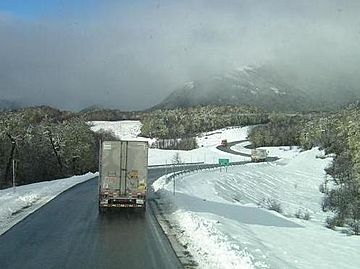Wet Andes facts for kids
Quick facts for kids Wet Andes |
|
|---|---|

View of Cardenal Antonio Samoré Pass during winter, latitude 41°S
|
|
| Highest point | |
| Peak | Domuyo |
| Elevation | 4,709 m (15,449 ft) |
| Dimensions | |
| Length | 2,500 km (1,600 mi) |
| Geography | |
| Country | Chile, Argentina |
| Parent range | Andes |

The Wet Andes (which means Andes húmedos in Spanish) is a special part of the huge Andes mountain range. It's known for its unique climate and glaciers. This area is one of the two main parts of the Andes found in Argentina and Chile.
The Wet Andes stretches for a long way. It goes from about 35 degrees South all the way down to Cape Horn at 56 degrees South. This means it covers a large southern part of the Andes.
Contents
What Makes the Wet Andes Special?
The Wet Andes is different from other parts of the Andes. A scientist named Luis Lliboutry helped classify it. One key difference is that you usually don't find "penitentes" here. Penitentes are tall, thin blades of hardened snow or ice. They look like people kneeling in prayer. In Argentina, you can find penitentes as far south as Lanín Volcano, which is around 40 degrees South. But in the Wet Andes, they are mostly absent.
Glaciers and Ice
Another thing that makes the Wet Andes unique is the lack of "rock glaciers." Rock glaciers are slow-moving mixtures of rock and ice. They are common in drier, colder mountain areas. But in the Wet Andes, you won't see many of them.
The glaciers in the Wet Andes are also very stable. This is because they get a lot of rain and snow, even in summer. They also have small changes in temperature. This means the ice melts less and stays frozen more often. This high moisture helps the glaciers keep their shape and size better than those in the Dry Andes.
Location and Geography
The Wet Andes covers a significant portion of the southern Andes. It runs along the border between Chile and Argentina. This region is known for its tall peaks and deep valleys. The highest point in the Wet Andes is Domuyo mountain, which stands at 4,709 meters (15,449 feet) tall.
Climate Features
The climate in the Wet Andes is very moist. This is due to winds coming from the Pacific Ocean. These winds bring a lot of moisture, which turns into rain and snow when it hits the mountains. This constant moisture is why the area is called "Wet Andes." It supports the many glaciers and helps keep the environment lush in some parts.
Images for kids
See also
 In Spanish: Andes húmedos para niños
In Spanish: Andes húmedos para niños



